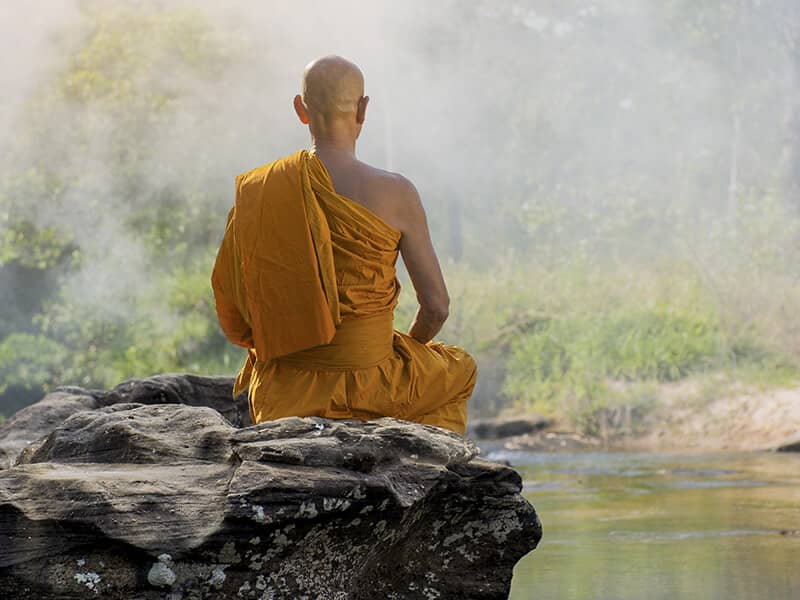In the Spring of 1991, the Asian Art Museum of San Francisco hosted a spectacular exhibition: "Wisdom and Compassion: the Sacred Art of Tibet." As part of the show, a team of Buddhist monks created a giant sand mandala, a sacred symmetrical "painting" made of countless grains of colored sand.
Three weeks into the process, when the work was nearly complete, a woman in red tennis shoes leaped onto the platform where the monks were working. Shouting nonsense, she stomped and danced across the delicate mandala, destroying the sacred image. The monks did not press charges, and the incident was dismissed as a fluke; another San Francisco loony, in the wrong place at the wrong time.
My own opinion was more considered. Several weeks earlier, the late Dr. Richard Kohn-co-curator of the show-had given me a tour of the exhibition. We walked into a room filled with thangkas: Tibetan devotional paintings, bristling with wrathful and benevolent dieties. Kohn showed me a thangka portraying Penden Lhamo, a dark and terrifying goddess.
Such images, he explained, would never be so casually displayed in Tibet; their imagery was too powerful, and far beyond the ken of novices. Tibetan monasteries kept them covered; for the very sight of them could drive a person insane. Remembering this, I considered the red tennis shoe woman in a new light. Had the very sight of the exhibition driven her mad?
If so, she was a person of rare sensitivity. Over the past twenty years, thousands of ritual thangkas--many hand-painted in Nepal and Tibet--have found their way into galleries and private homes across the United States and Europe. While they remain devotional works, these paintings are often casually displayed; like Balinese masks, or Mexican milagros.. No longer power objects, they become mere travel trophies.
Many of the works in "Celestial Gallery" are mandalas: idealized visions of celestial realms, used as tools in meditation. Others portray potent Buddhist deities, each symbolizing a subtle state of human awareness--or an indispensible ally on the path toward illumination.
Shrestha does not pretend that the works in "Celestial Gallery" are strictly traditional. "These paintings," Baker explains in his introductory remarks, "represent a school of contemporary Nepalese art that could almost be called postmodern; they adopt the visual components of an ancient iconographical tradition and present them in new contexts unconstrained by religious and artistic conventions."
Armed with that caveat, Shrestha takes some unusual liberties--like placing a Hindu yantra, or sacred visual device, smack in the middle of a Buddhist mandala. Cartoonish dragons swirl around an intricate painting of Chakrasamvara, the Wheel of Bliss. In the corner of one work, human skeletons are shown playing cards-a playful tableaux that recalls the artworks of Mexico's Dia de los Muertos.
As in his previous book ("The Tibetan Art of Healing", also with Baker), Shrestha claims the paintings as his own; in reality, they are mainly executed under his direction, by a workshop of artist-craftsmen. And while devotional thangkas are traditionally painted anonymously--or by well-known artists admired for their humility--Shrestha signs his works with a metaphorical flourish, pleased to be proclaimed--in Deepak Chopra's otherwise useful forward--as a visionary.
If those are the grounds for suspicion, the grounds for admiration are equally compelling. The book is stunningly beautiful, a tour-de-force of Asian devotional art. Yamantaka, Vanquisher of Death, explodes from the page with the terrifying presence of Marvel comics villain (the vivid, almost cartoonish presentation is typical of the Newari style). Vajrasattva, guide to the mind's enlightened essence, embraces his consort within a nimbus of black and gold. Amatayus, the crimson-skinned Buddha of Boundless Life, radiates within a mandala so richly hued that it calls to mind the rose windows of Notre Dame.
Baker, a Kathmandu-based writer and Himalayan explorer, is a character no less colorful than Shrestha. Last October, his co-discovery of the "Hidden Falls of the Brahmaputra" made international news. Here, in his role as tantric scholar, Baker has the daunting task of illuminating these paintings in a way that is both accesible and unpatronizing. He succeeds brilliantly, seeding his poetic mini-essays with quotes from mystics, philosophers and the great Dalai Lamas. It's a bit irritating that each page of text also features a fortune-cookie homily from Shrestha himself, reducing Baker's thoughtful commentary to "enlightenment lite."
The book's masterpiece, at least in terms of explanation, is the "Wheel of Deluded Existence." The entire mandala is skillfully deconstructed, with every scene and object clearly described. In the circle's center, three animals-a pig, rooster and snake-symbolize the ignorance, greed and aggression of samsara: the unenlightened state. Surrounding this core are lively representations of the six realms-gods, devas, humans, hungry ghosts, animals and hell-divided like pizza slices.
Each realm has a corresponding property: pride; envy; desire; greed; ignorance; anger. These realms, as we know, are not mere abstractions. Our minds pass through all of them, many times each day. If we need any further convincing, we have only to look to the borders-where the Wheel is shown in the clutches of Mara, the great deceiver. His crown bristles with skulls, symbolizing our inevitable death.
Neither enlightenment, nor madness, is likely to arise from this marvelous collection of contemporary Buddhist art. But it will inform and inspire anyone who sets eyes on it-and shed new light on the impressive, but little-understood, thangkas adorning more than a few western walls.

